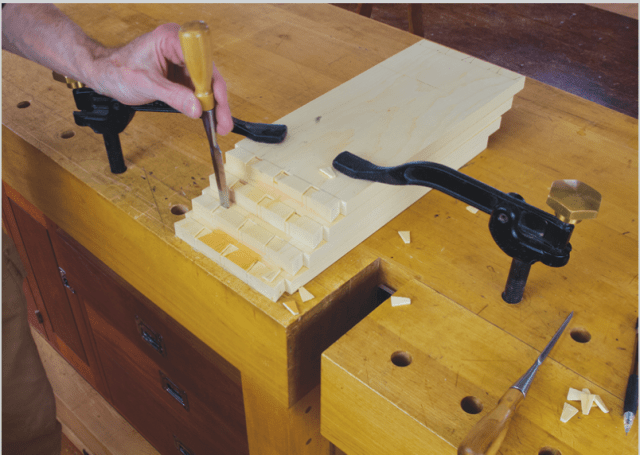
The following is excerpted from “Shaker Inspiration” by Christian Becksvoort.
Not too many woodworkers can claim five decades of business success, but Becksvoort is among them. In “Shaker Inspiration,” he shares not only his woodworking knowledge and some of his best professional techniques for producing top-quality work, but also the business advice that helped him establish and sustain his long career in a one-man shop. Plus, he shares measured drawings for 13 of his own well-known furniture designs and seven Shaker pieces that he’s reproduced.
I stack my parts four or six high. That way I only clamp once on each side, for all parts. Let’s say it takes four hits per side to get halfway into each socket, or eight hits altogether. That means I have to switch chisels eight times (a wide chisel for the baseline, then a narrow chisel to remove the waste). If I do one socket at a time, and I have 12 sockets to chop, that means I switch chisels 96 times. By cutting all baselines on all pieces, then switching chisels and removing the first 1/16″ (.16cm) of waste, I save a lot of time.

Switching to a narrow chisel, I take out a thin sliver of waste on all the tails. Then I set the other chisel up against the shoulder I’ve just created at the scribe line, and give it a profound whack. I tend to tilt the chisel forward about 1°, to undercut the waste. Again I chop all of them, switch chisels, remove waste and do it once more, until I reach the middle of the tail boards. Then I flip them all over, re-clamp, and proceed in the exact same manner on the other side.

When done, I clamp each board upright in my vise, then clean the corners with a thin-bladed knife. Remember that bevel-edged chisels have a narrow 90° edge, and the dovetail angles are less. There is almost always a bit of waste in each corner. We like crisp, clean tails, right into the corners.





Had no idea of how many tool touches, for a simple box with dovetails, were involved. Thanks for this insight. Nice bench dogs, love the brass tightening knob, what brand are they?
Lee Valley Veritas.
https://www.leevalley.com/en-us/shop/tools/workshop/workbenches/benchtop-accessories/31149-veritas-hold-down
Brilliant.
Tage Frid method. From his Joinery book. How I learned to do it in the 70’s.
In addition to baker’s dozen of his iconic pieces, great tips like above, there is really good business advice in the book. It’s one of my favorite LAP books. All given in concise writing which seems symbolic of the Shaker style of furniture.
Very helpful technique. I think the last two photos have been interchanged…
I think you’re right. I checked in the book (both the physical book, and the Jan. 2020 PDF), and it looks like those two pictures are reversed in both.
Oh dear. We’ll make a note to fix it at the next printing.
Interesting and informative. What I wonder is how, with the pieces stacked, one avoids dinging the board underneath.
In theory, one only removes half of the waste in each go. The only issue is if the waste gives way earlier than expected on the second round… 😉
As with everything, practice
The steady stream of (mostly) woodworking wisdom here is a wonderful thing. Thanks all.
Has anyone else noticed issues with the RSS feed, or is it just me? Mine is updating for other blogs, but not LAP…
I just arrived here from my RSS reader, it seems to be catching LAP OK.
A week’s worth just showed up in mine – maybe something came unstuck?
In the beginning was the Lap joint ?
Not strictly relevant to this discussion but I thought it might be of interest:
https://www.liverpool.ac.uk/feature/oldest-wooden-structure/
Would love to see a video on this method.
Would be great to see a video of this, especially to get the idea of working on multiple boards at once.
Allow me to Google that for you: https://www.youtube.com/watch?v=7qDWkbyZEZQ